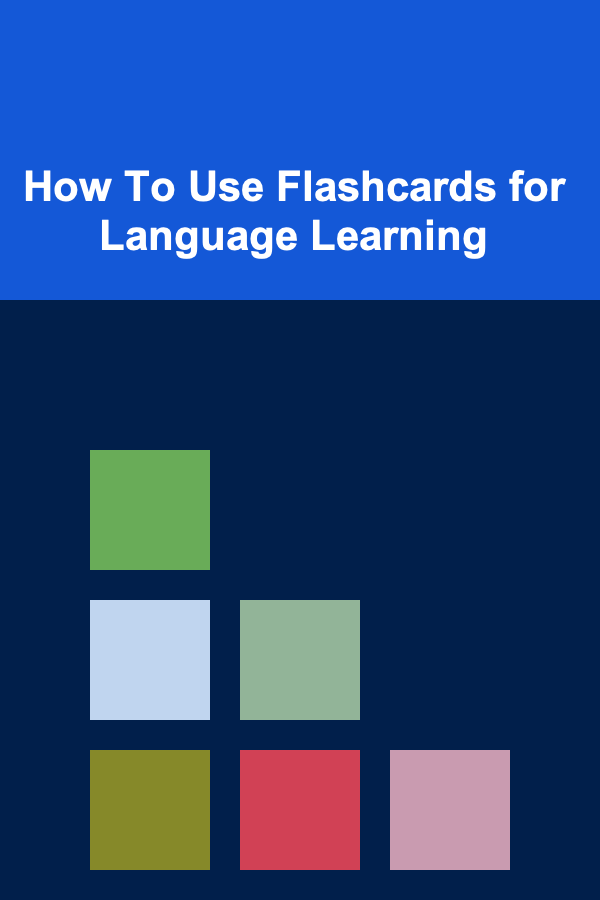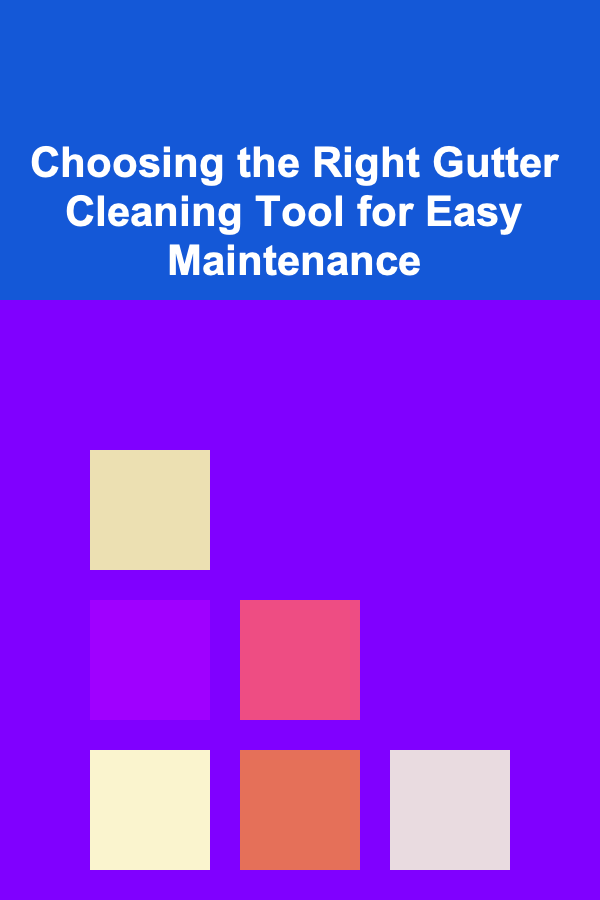
How To Use Flashcards for Language Learning
ebook include PDF & Audio bundle (Micro Guide)
$12.99$8.99
Limited Time Offer! Order within the next:

Learning a new language can often feel overwhelming due to the sheer volume of vocabulary, grammar rules, and pronunciation nuances that one must master. However, one tool that has proven to be both effective and efficient in aiding language acquisition is the humble flashcard. Flashcards have been used for centuries as a memory aid, and their application in language learning has gained considerable attention for their ability to enhance vocabulary retention, grammar practice, and even pronunciation skills. In this article, we will explore how to effectively use flashcards for language learning, taking into account the psychology of memory, best practices, and advanced techniques to maximize learning efficiency.
The Power of Flashcards: Understanding Memory
Before diving into the mechanics of using flashcards for language learning, it's essential to understand how they work from a cognitive perspective. Flashcards leverage the brain's natural ability to memorize information through repetition and active recall. The principles behind flashcards align with two key psychological concepts:
1. Active Recall
Active recall refers to the process of retrieving information from memory rather than passively reading or reviewing notes. When you try to recall a word or phrase from a flashcard, your brain engages in active recall, which strengthens your memory of that word or concept. This active process forces your brain to retrieve and reinforce the connection between the word and its meaning, leading to more effective long-term retention.
2. Spaced Repetition
Spaced repetition is another key principle that enhances learning. The idea is simple: information is reviewed at increasing intervals over time to help move it from short-term to long-term memory. The more spaced out the repetitions, the better you will retain the information. Flashcards are ideal for implementing spaced repetition because you can schedule reviews based on how well you recall a given word or concept. Tools like Anki and Quizlet use algorithms to ensure that cards are reviewed at optimal intervals.
The Basics of Flashcard Creation
The first step in using flashcards for language learning is creating them. You can make flashcards using physical index cards or digital apps. Both have their advantages, but digital tools often offer features like automated spaced repetition and portability that physical cards cannot match. Below are some basic guidelines to follow when creating flashcards:
1. Choose a Specific Focus
Instead of trying to create flashcards for an entire language, it's best to narrow your focus. Language learning has various components---vocabulary, grammar, pronunciation, and more. You can create separate sets of flashcards for different aspects, such as:
- Vocabulary: Write the target word on one side and its meaning, translation, or a sentence using the word on the other.
- Grammar: Create flashcards with sentences demonstrating grammar rules on one side and the rule explanation on the other.
- Pronunciation: Use flashcards with phonetic symbols, audio recordings, or examples of how a word should sound.
2. Use Simple and Clear Information
Each flashcard should present a single piece of information. For vocabulary, this means the word in the target language on one side and its meaning in your native language (or a sample sentence) on the other. Simplicity is key, as trying to cram too much information onto a single card can make it harder to focus and retain details.
3. Incorporate Context
Language is not just about memorizing words; it's also about understanding how to use them in context. Whenever possible, try to include example sentences that show how the word is used in a typical conversation. For example:
- Front: "Guten Morgen" (Good morning)
- Back: "Guten Morgen! Wie geht's dir?" (Good morning! How are you?)
This will help you see how words and phrases function within the structure of the language, making it easier to use them in real conversations.
4. Visual Associations
Whenever possible, add images or visual cues to your flashcards. This is especially effective for nouns. For example, for the word "dog," you can include a picture of a dog on the card. Associating a word with an image will help strengthen the connection in your brain, making it easier to recall the word later. This method, known as dual coding, makes the information stick by engaging both visual and verbal parts of your brain.
Best Practices for Flashcard Use
Once your flashcards are ready, the next step is knowing how to use them effectively. It's not enough just to flip through them passively. To truly benefit from flashcards, you need to engage actively with the material. Below are some best practices to help you get the most out of your flashcards:
1. Review Regularly
The key to success with flashcards is consistency. Set aside time each day to go through your flashcards, even if only for 15-20 minutes. This daily review session will reinforce what you've learned and ensure that you are retaining information over time. The more frequently you review, the more likely you are to commit words and phrases to long-term memory.
2. Use Spaced Repetition
As mentioned earlier, spaced repetition is crucial for retaining information. Many digital flashcard tools like Anki and Quizlet automatically organize your flashcards for review based on the spaced repetition algorithm. These tools track your progress and review cards that you struggle with more frequently, while giving you a longer break from those you've already mastered.
In a physical system, you can use a 3-box method. When you get a card correct, place it in box 1 (cards you need to review soon). If you get a card correct again, move it to box 2 (cards you should review later). Eventually, move it to box 3 for infrequent review. This system ensures that you prioritize the most difficult material while gradually spacing out easier material.
3. Test Yourself
Active recall is most effective when you test yourself. When you look at the front of a flashcard, try to recall the meaning or the translation before flipping it over. If you don't remember it, spend more time reviewing the card and try again later. Over time, this will improve your ability to recall information quickly.
4. Mix Up the Cards
It's easy to get into a routine where you memorize the order of your flashcards, which can lead to memorizing the sequence rather than the actual content. To avoid this, shuffle the deck regularly. This will force your brain to retrieve information in a non-sequential manner, which strengthens memory recall.
5. Use Multiple Senses
If you are using digital flashcards, take advantage of features like audio recordings. Listening to a word and hearing its pronunciation will reinforce your memory, especially for languages with complicated sounds or unfamiliar alphabets. You can also record yourself speaking or repeat the words out loud as you go through your flashcards. This method engages both your auditory and verbal memory systems.
6. Focus on Problem Areas
As you progress with your flashcards, certain words or concepts will be more difficult than others. Focus on these problem areas by reviewing difficult cards more frequently. This will help ensure that the harder material gets reinforced over time. Many digital flashcard apps automatically identify which cards you struggle with and show them to you more often, making this process more efficient.
7. Don't Overload Yourself
While it can be tempting to make hundreds of flashcards, it's best to start small and gradually increase the number. Overloading yourself with too many flashcards at once can lead to burnout and frustration. Start with a manageable set of words, and increase the number as you become comfortable with the material. Quality over quantity is key to success with flashcards.
Advanced Flashcard Techniques
While the basic use of flashcards is powerful, there are advanced techniques that can further enhance your language learning experience. These techniques are particularly useful for learners who are at intermediate or advanced stages of language learning.
1. Use Cloze Deletions
A cloze deletion is a fill-in-the-blank exercise. You can create flashcards that remove a key part of the sentence or word and require you to recall it. For example, instead of simply writing the word "banana," you could write: "I like to eat _____ for breakfast," and on the back, include the answer "banana." This technique engages your brain more actively by requiring you to use contextual clues.
2. Use Mnemonic Devices
Mnemonics are memory aids that help you recall difficult words. For example, for the German word "Apfel" (apple), you could create a mnemonic like "Ape fell for the apple." Creating these mental associations can make vocabulary easier to remember.
3. Incorporate Grammar Practice
While vocabulary is essential, grammar is the backbone of any language. You can create flashcards that focus on grammatical structures or common verb conjugations. For example, you could write the sentence "I eat" on one side and its translation in your target language on the other. Another flashcard could present the conjugation of a verb in different tenses or with different pronouns.
4. Learn Phrases, Not Just Words
Rather than focusing on individual words, you can learn useful phrases that you are likely to use in everyday conversation. This can make it easier to remember vocabulary in context. For example, instead of memorizing the word "restaurant," learn the phrase "I would like to make a reservation at a restaurant."
Conclusion
Flashcards are a proven and highly effective tool for language learning, offering a combination of cognitive science principles and flexibility that suits learners of all levels. Whether you are a beginner trying to master basic vocabulary or an advanced learner working on grammar and pronunciation, flashcards provide a structured and interactive way to reinforce what you have learned.
By following the best practices outlined in this article, such as reviewing regularly, using spaced repetition, and mixing up your cards, you can ensure that your language skills continue to improve. Advanced techniques like cloze deletions and mnemonic devices can further accelerate your learning process, helping you to retain more vocabulary and gain greater fluency in your target language.
Ultimately, the power of flashcards lies in their ability to engage your brain in active recall and spaced repetition, which are two of the most effective memory techniques available. With consistent practice, flashcards can become an indispensable part of your language learning routine, helping you to unlock the world of communication in a new language.

How to Create Compelling Product Listings That Drive Sales
Read More
How to Make a Checklist for Running Effective Social Media Ad Campaigns: An Actionable Guide
Read More
How to Make Family Time More Fun with DIY Indoor Sports
Read More
How to Save for a Large Purchase Without Sacrificing Other Goals
Read More
Magnetism Mastery: How to Stand Out by Attracting the Right People
Read More
Choosing the Right Gutter Cleaning Tool for Easy Maintenance
Read MoreOther Products

How to Create Compelling Product Listings That Drive Sales
Read More
How to Make a Checklist for Running Effective Social Media Ad Campaigns: An Actionable Guide
Read More
How to Make Family Time More Fun with DIY Indoor Sports
Read More
How to Save for a Large Purchase Without Sacrificing Other Goals
Read More
Magnetism Mastery: How to Stand Out by Attracting the Right People
Read More